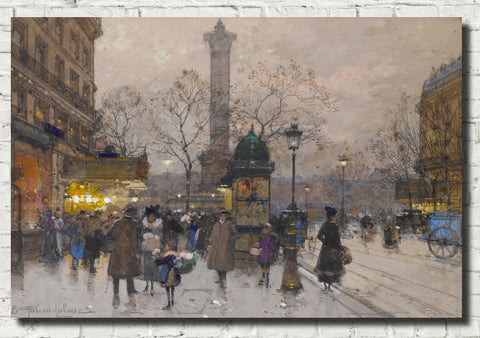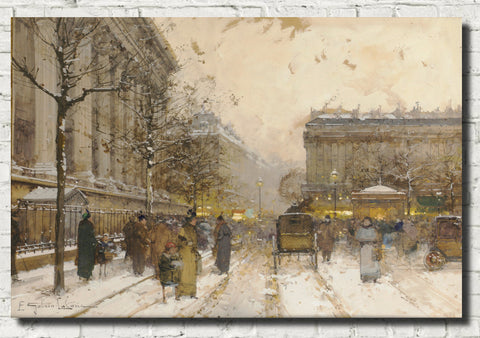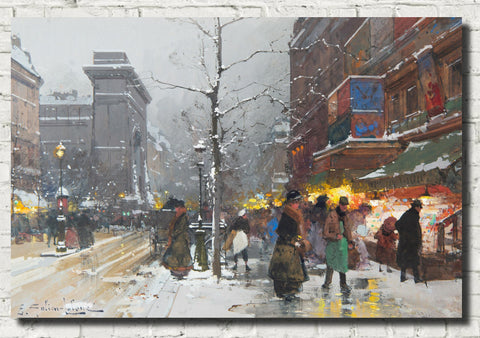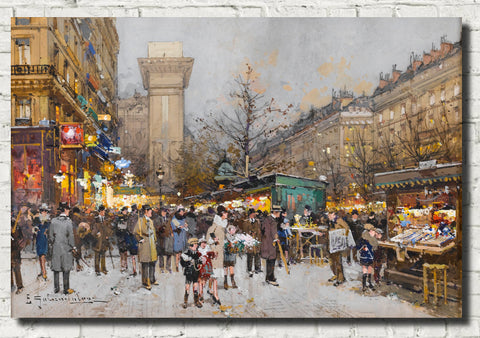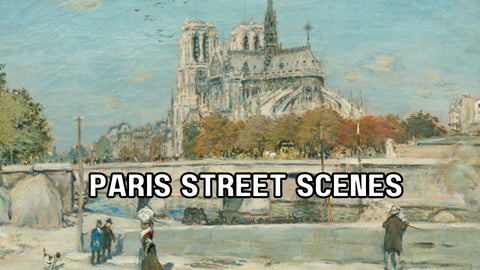Eugène Galien-Laloue: Parisian Street Paintings
Table of Contents:[hide]
Eugène Galien-Laloue, a distinguished French artist, left an indelible mark on the art world with his captivating depictions of Parisian street scenes. Born on December 11, 1854, Galien-Laloue's works continue to enchant art enthusiasts worldwide, offering a window into the vibrant atmosphere of la Belle Époque.
Biography of Eugène Galien-Laloue
Eugène Galien-Laloue's artistic journey began in Paris, where he was born to French-Italian parents. His paintings, particularly those from the early 1900s, serve as poignant reflections of the era in which he lived. Through meticulous brushstrokes, Galien-Laloue captured the essence of a bustling Paris, adorned with horse-drawn carriages, trolley cars, and the city's first omnibuses.
A Glimpse into Galien-Laloue's Artistic Style
Galien-Laloue's oeuvre primarily revolves around street scenes teeming with life. His attention to detail and masterful use of light and shadow transport viewers to the sidewalks and avenues of Paris, where people and tourists congregate against the backdrop of iconic monuments. Additionally, the artist ventured beyond the city limits, immortalizing the landscapes of Normandy and Seine-et-Marne with equal finesse.
Contributions to Art and History
Beyond their aesthetic appeal, Galien-Laloue's paintings serve as valuable historical documents. They offer insights into the daily life of Parisians during the late 19th and early 20th centuries. Moreover, the artist was commissioned to create military scenes during significant conflicts, including the Franco-Prussian War and World War I. His role as a 'war artist' underscores the intersection of art and history in his body of work.
Marketing Strategies and Pseudonyms
Galien-Laloue's entrepreneurial spirit extended beyond the canvas. He maintained an exclusive contract with one gallery but utilized various pseudonyms—such as "L.Dupuy," "Juliany," and "P.Mattig"—to broaden the reach of his paintings. This strategic approach enabled him to market his creations effectively while navigating the complexities of the art market.
Legacy and Recognition
Today, the legacy of Eugène Galien-Laloue endures through his enduring contributions to Impressionism. His works are housed in esteemed institutions such as the Musée des Beaux-Arts in Louvier and La Rochelle, France, preserving his artistic legacy for future generations to appreciate.
Conclusion
Eugène Galien-Laloue's artistry transcends mere brushstrokes, offering a timeless portrayal of Parisian life during a bygone era. Through his paintings, he invites viewers to immerse themselves in the charm and vibrancy of la Belle Époque, while also leaving behind a rich legacy that continues to inspire and captivate.
Eugène Galien-Laloue Prints and Canvas Panels
Prints and ready to hang canvas panels of Eugène Galien-Laloue's paintings are available in a range of sizes with fast worldwide delivery.
Eugène Galien-Laloue FAQ's
-
Who was Eugène Galien-Laloue?
Eugène Galien-Laloue was a prominent French artist known for his captivating paintings of Parisian street scenes and landscapes. Born in 1854, he gained recognition for his meticulous attention to detail and masterful use of light and shadow.
-
What is Eugène Galien-Laloue's artistic style?
Galien-Laloue's artistic style is often associated with Impressionism. He excelled in portraying bustling urban scenes, capturing the essence of everyday life in Paris during the late 19th and early 20th centuries. His works are characterized by vibrant colors, dynamic compositions, and a keen sense of atmosphere.
-
What themes did Eugène Galien-Laloue explore in his paintings?
Galien-Laloue primarily focused on depicting street scenes, often featuring crowds of people, bustling thoroughfares, and iconic landmarks of Paris. Additionally, he ventured into portraying landscapes, particularly those of Normandy and Seine-et-Marne. He also created military scenes during his time as a commissioned 'war artist.'
-
What is the significance of Eugène Galien-Laloue's paintings?
Beyond their aesthetic appeal, Galien-Laloue's paintings serve as valuable historical documents, offering insights into the social and cultural fabric of Paris during the Belle Époque era. They provide a glimpse into the daily life, architecture, and transportation of the time, preserving a slice of history for future generations.
-
How did Eugène Galien-Laloue market his paintings?
Galien-Laloue employed various pseudonyms, such as "L.Dupuy" and "Juliany," to market his paintings more broadly outside of his exclusive gallery contracts. This strategic approach allowed him to reach a wider audience and navigate the competitive art market of his time effectively.
-
Where can one view Eugène Galien-Laloue's artwork?
Galien-Laloue's paintings can be found in esteemed institutions such as the Musée des Beaux-Arts in Louvier and La Rochelle, France. Additionally, his works are often featured in art galleries, exhibitions, and private collections worldwide, showcasing his enduring legacy in the realm of Impressionism.
-
What was Eugène Galien-Laloue's contribution to the art world during times of conflict?
Galien-Laloue was commissioned as a 'war artist' during significant conflicts, including the Franco-Prussian War and World War I. His role involved creating military scenes, documenting the realities of war through his art. This aspect of his career highlights the intersection of art and history in his body of work.


















